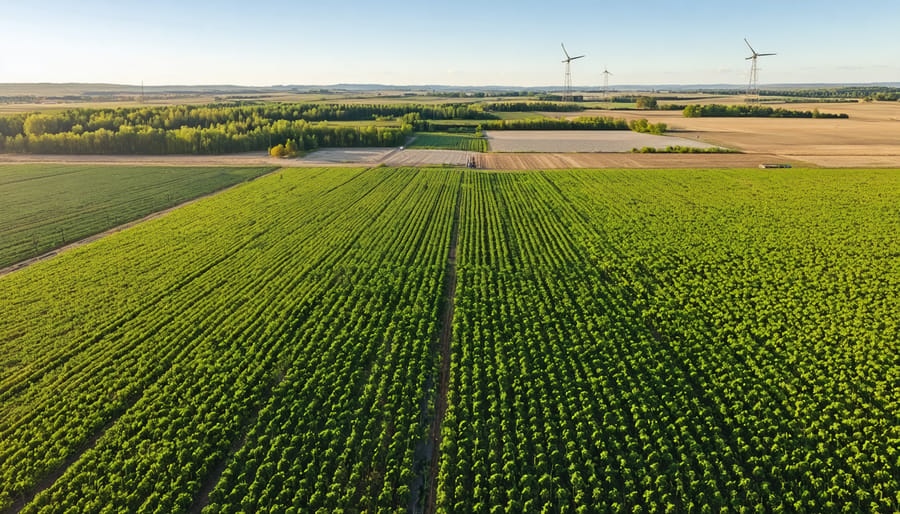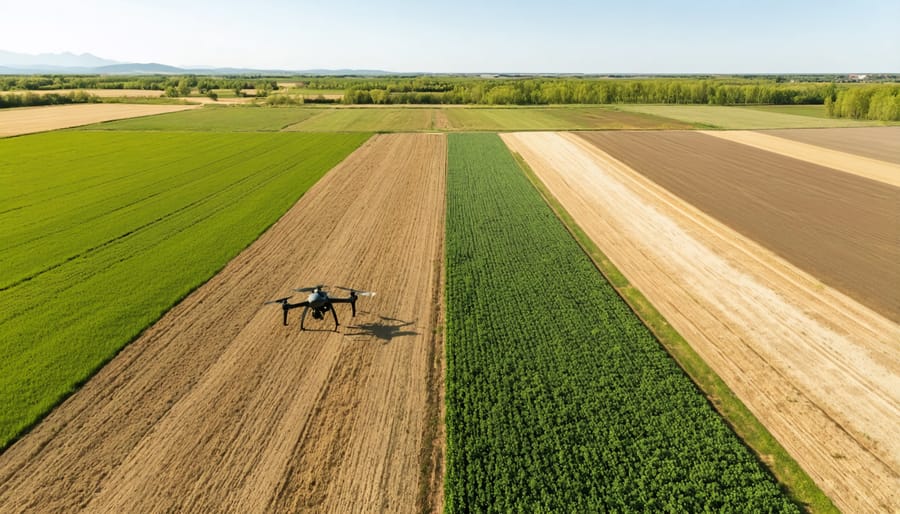Deploy companion planting techniques by surrounding vulnerable crops with pest-deterrent species like marigolds, nasturtiums, and dill to create natural defensive barriers across your fields. Release beneficial insects strategically – ladybugs, praying mantises, and parasitic wasps establish lasting biological control while maintaining crucial pollinator populations. Implement natural pest management strategies through crop rotation, shifting susceptible plants to new locations every season to disrupt pest life cycles and preserve soil health. Build resilient growing environments using locally-sourced mulch and compost tea applications that strengthen plant immunity and create hostile conditions for common Alberta agricultural pests.
These field-tested organic methods have helped Prairie farmers reduce pest pressure by up to 60% while meeting Canadian organic certification standards. Backed by research from Agriculture and Agri-Food Canada, these approaches work synergistically to protect crops throughout Alberta’s unique growing season without compromising long-term soil and ecosystem health.
Biological Warriors: Beneficial Insects in Your Fields
Native Predator Species
Alberta’s ecosystem is home to numerous beneficial insects that naturally help control pest populations. Ladybugs, particularly the native Seven-spotted and Thirteen-spotted species, are voracious aphid predators, with a single adult capable of consuming up to 5,000 aphids during its lifetime. These spotted allies are particularly active in canola and pulse crops throughout the province.
Ground beetles, abundant in Alberta’s agricultural lands, are nocturnal hunters that feed on slugs, cutworms, and other soil-dwelling pests. These beneficial insects work tirelessly during the night, protecting root systems and emerging seedlings. Parasitic wasps, including the native Trichogramma species, effectively control moth eggs and caterpillars in vegetable crops and orchards.
Green lacewings, often found in Alberta’s grain fields and gardens, are exceptional pest controllers. Their larvae, nicknamed “aphid lions,” feast on spider mites, thrips, and various soft-bodied insects. One lacewing larva can devour up to 200 aphids per week.
Prairie farmers often spot hover flies (also known as syrphid flies) among their crops. These beneficial insects not only help with pollination but their larvae also consume significant numbers of aphids and other soft-bodied pests. To attract and maintain these natural predators, consider planting native flowering species around field edges and maintaining undisturbed areas where these beneficial insects can overwinter.
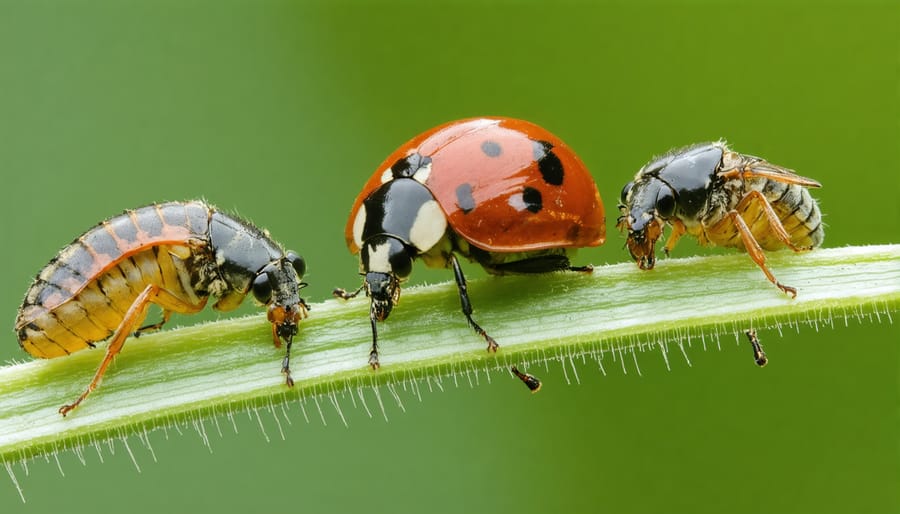
Creating Insect-Friendly Habitats
Creating a welcoming environment for beneficial insects is one of the most effective long-term strategies for organic pest control. Here in Alberta, we’ve seen remarkable success with farmers who dedicate even small portions of their land to insect-friendly spaces.
Start by establishing diverse flowering plants along field margins and between crop rows. Native species like yarrow, golden rod, and aster are particularly effective at attracting beneficial insects while being well-adapted to our climate. Aim to have something blooming throughout the growing season to provide continuous nectar sources.
Leave undisturbed areas around your fields where beneficial insects can overwinter. This might include brush piles, unmowed grass strips, or beetle banks. Many Alberta farmers have found success by maintaining 3-metre-wide permanent grass strips every 100 metres across larger fields.
Water sources are crucial but often overlooked. Simple shallow dishes filled with pebbles and water, or small ground-level ponds, provide drinking spots for beneficial insects. In our dry prairie climate, these water sources can make the difference in establishing stable populations.
Consider incorporating companion planting strategies. Dill, fennel, and caraway are excellent choices that attract parasitic wasps and other helpful predators. Local success stories include farmers who’ve reduced pest problems by up to 60% through strategic habitat creation.
Remember that establishing these habitats takes time – expect to see significant results within two to three growing seasons as beneficial insect populations establish themselves.
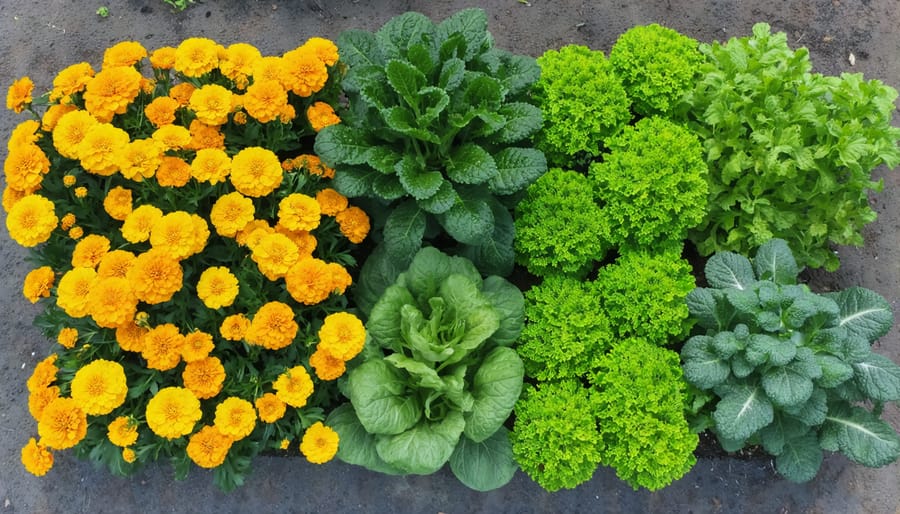
Companion Planting Strategies for Prairie Farms
Strategic Plant Combinations
In Alberta’s unique climate, strategic plant combinations play a vital role in successful organic farming techniques. Companion planting pairs include marigolds with brassicas (cabbage, broccoli, and cauliflower) to deter cabbage moths and root-damaging nematodes. Plant dill and carrots together, as dill attracts beneficial wasps that control carrot rust flies.
For potato patches, consider planting horseradish around the borders. This hardy combination naturally deters potato beetles and enhances potato flavour. Incorporate nasturtiums throughout your garden – they act as trap crops for aphids while adding splashes of colour.
Indigenous Three Sisters planting (corn, beans, and squash) works remarkably well in our climate. The corn provides support for climbing beans, which fix nitrogen in the soil, while squash leaves create natural ground cover that reduces weed growth and maintains soil moisture.
For greenhouse settings, pair tomatoes with basil to improve growth and flavour while repelling whiteflies and hornworms. Plant chives near apple trees to prevent apple scab and enhance fruit production. These combinations have proven particularly effective in our Zone 2-4 growing conditions.
Implementation Timeline
Spring planning begins in March with the preparation of your companion planting strategy. Start by mapping out your field layouts and identifying beneficial plant pairs. In early April, sow hardy companion plants like dill, yarrow, and marigolds in your greenhouse to get a head start on the season.
By mid-May, when soil temperatures reach 10°C, begin transplanting your companion plants alongside your main crops. Plant aromatic herbs like basil and oregano near tomatoes and cabbage families. Consider alternating rows of carrots with onions to deter carrot flies, a common pest in Alberta.
Summer maintenance peaks in June and July. This is the time to establish flowering companions like borage and calendula, which attract beneficial insects. Plan for succession planting of quick-growing companions like buckwheat to maintain continuous pest protection throughout the season.
For fall preparation, starting in late August, begin planting cold-hardy companions like winter wheat or rye as cover crops. These not only suppress weeds but also provide habitat for beneficial insects during winter months.
Remember to document your companion planting combinations and their effectiveness each season. This record-keeping helps refine your strategy for the following year, adapting to your farm’s specific needs and local pest pressures.
Natural Sprays and Solutions
Locally-Sourced Ingredients
Canada’s diverse landscape provides an abundance of natural ingredients perfect for organic pest control. Here in Alberta, we’re fortunate to have access to many locally-sourced materials that can help protect our crops while maintaining ecological balance.
Neem trees, while not native to Canada, are now being successfully greenhouse-grown in several Alberta locations, providing a sustainable local source of this powerful natural pesticide. Prairie sage, abundant throughout the province, serves as an excellent natural repellent for many common crop pests.
Local garlic producers offer another valuable resource. Many Alberta farmers partner with garlic growers to source ingredients for homemade pest sprays. The strong compounds in locally-grown garlic have proven particularly effective against aphids and various soil-borne pests.
Our boreal forests provide access to pine needles and cedar chips, which can be used as natural mulch with pest-deterrent properties. Many Indigenous communities have long used these materials for traditional pest management, offering valuable insights into their effective application.
Several Alberta apiaries produce high-quality beeswax, essential for making protective barriers against crawling insects. Additionally, local horsetail, which grows abundantly in our wetlands, can be harvested and fermented to create a natural fungicide rich in silica.
These locally-sourced options not only support regional businesses but also ensure that our pest control methods are adapted to our specific growing conditions and pest challenges.
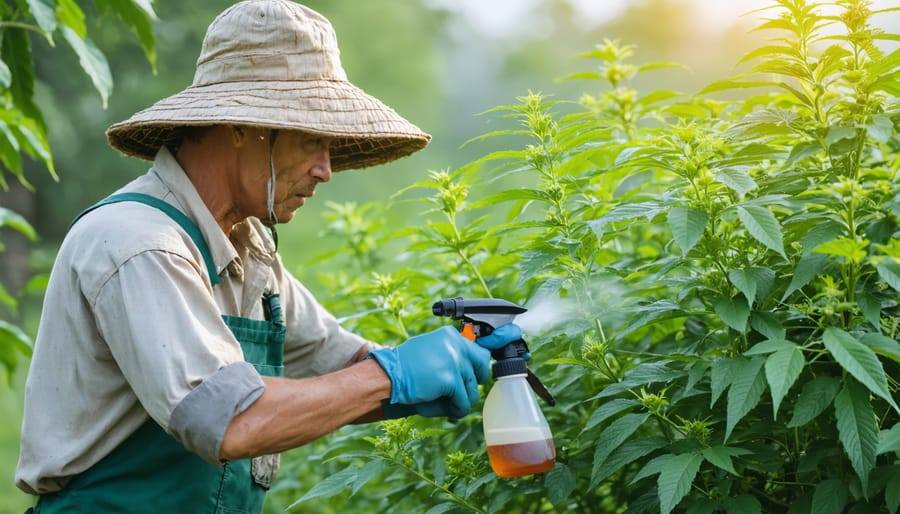
Application Methods
Timing is crucial when applying organic pest control solutions. In Alberta’s climate, early morning or late evening applications typically yield the best results, as beneficial insects are less active and solutions won’t evaporate quickly in the hot sun. For foliar sprays like neem oil or garlic solutions, ensure complete leaf coverage, including the undersides where pests often hide.
When using biological controls such as beneficial nematodes, soil temperature should be between 10°C and 30°C for optimal effectiveness. Apply these during overcast conditions or water the area beforehand to protect these beneficial organisms from harmful UV rays. For companion planting, space your protective plants strategically – about 30-45 cm apart for most species – to create effective pest barriers while maintaining good airflow.
Local farmer Jim Henderson from Red Deer shares, “I’ve found that rotating my organic sprays every two weeks helps prevent pest resistance. I also keep detailed records of application times and weather conditions to optimize future treatments.”
Remember to reapply natural solutions after rainfall or heavy dew. Most organic treatments need weekly applications during peak pest seasons. Always test new solutions on a small area first and monitor for 24-48 hours before full application. For best results, establish a regular monitoring schedule to catch pest issues early when organic controls are most effective.
Cultural Control Methods
Crop Rotation Benefits
Crop rotation stands as one of the most powerful sustainable farming practices for managing pests naturally in Alberta’s diverse agricultural landscape. By changing crop locations each season, you disrupt pest life cycles and reduce their population buildup effectively.
For optimal results in our Prairie climate, implement a minimum four-year rotation plan. Start with a deep-rooted crop like alfalfa, followed by heavy feeders such as corn or wheat, then switch to legumes like field peas, and finish with shallow-rooted vegetables. This sequence naturally breaks pest cycles while improving soil structure.
Local success stories demonstrate the effectiveness of this approach. The Morrison Family Farm in Red Deer reported an 80% reduction in root maggot infestations after implementing a strategic rotation plan. They alternated canola with cereals and pulse crops, effectively managing both soil-borne pests and airborne insects.
Remember to group crops by family when planning rotations. For example, don’t follow potatoes with tomatoes or peppers, as they share similar pest vulnerabilities. Instead, rotate between plant families: brassicas, nightshades, legumes, and alliums. This approach helps maintain beneficial insect populations while naturally suppressing harmful ones.
For small-scale operations, consider incorporating flowering cover crops between main crop rotations. These attract beneficial insects and create natural pest control corridors throughout your fields.
Soil Health Management
The foundation of successful organic pest control lies in maintaining healthy, living soil. When you improve soil health, you naturally strengthen your crops’ resistance to pests and diseases. Here in Alberta, our farmers have found success with a three-pronged approach to soil management.
First, maintain optimal soil structure through regular addition of organic matter. Composted manure, cover crops, and crop residues create a robust environment for beneficial microorganisms. These microbes form partnerships with plant roots, enhancing natural defense mechanisms against pests.
Second, practice crop rotation to break pest cycles and maintain soil nutrient balance. A well-planned four-year rotation system, common among successful Prairie farmers, prevents pest populations from establishing themselves while naturally replenishing soil nutrients.
Third, implement minimal tillage practices where possible. This preserves soil structure and protects beneficial organisms like earthworms and nematodes, which help control harmful pests naturally. Calgary-based farmer Sarah Thompson reports a 40% reduction in root-feeding pests after switching to reduced tillage practices.
Monitor your soil’s pH and nutrient levels through regular testing, adjusting as needed with approved organic amendments. Remember, healthy soil produces resilient plants that naturally resist pest pressure, reducing the need for intervention later in the growing season.
As we’ve explored throughout this guide, organic pest control methods offer practical, sustainable solutions for Canadian farmers looking to protect their crops while maintaining ecological balance. The success stories from Alberta farms demonstrate that these methods aren’t just environmentally sound – they’re economically viable too.
By implementing integrated approaches like companion planting, beneficial insect attraction, and physical barriers, you can build a resilient agricultural system that works with nature rather than against it. Remember that transitioning to organic pest control is a journey that can be taken one step at a time, allowing you to learn and adapt as you go.
The key to success lies in prevention and observation. Regular monitoring of your fields, understanding pest life cycles, and maintaining healthy soil will significantly reduce the likelihood of serious infestations. When challenges do arise, you now have a toolkit of solutions, from natural predators to botanical sprays, that can effectively address pest issues while preserving the health of your land.
Consider connecting with local organic farming networks and agricultural extension services. The experiences of fellow Alberta farmers who’ve successfully implemented these methods can provide valuable insights and support as you develop your own organic pest management strategy.
As our climate continues to change and consumers increasingly demand sustainable agricultural practices, organic pest control methods become not just an alternative, but a smart investment in your farm’s future. By taking steps today to implement these methods, you’re contributing to a more sustainable agricultural future while protecting your bottom line.
Start small, observe carefully, and remember that every positive change, no matter how modest, moves us toward more sustainable farming practices in Canada.




